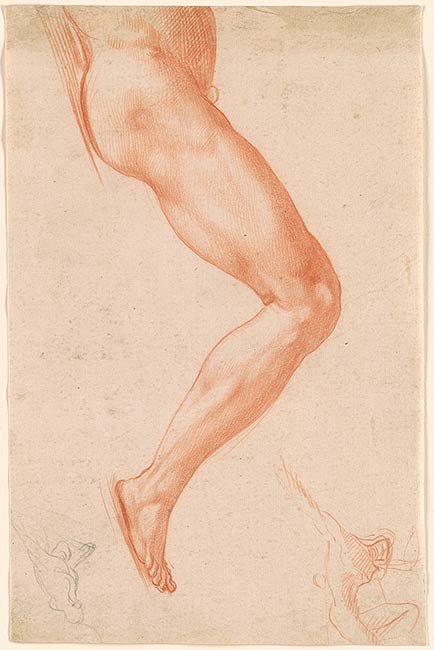
The drawing entered the collection of Pierpont Morgan under its traditional attribution to Rosso Fiorentino, which by the 1950s was no longer considered correct. In 1994 Linda Wolk-Simon suggested that the drawing is Perino del Vaga’s study for the figure of the Good Thief in his Deposition in Santa Maria sopra Minerva, begun around 1520 and completed shortly after the plague of 1522.1 The painting was destroyed in 1530 but a fragment showing the Good Thief is at Hampton Court. This connection, however, is not convincing; besides the stylistic differences to Perino’s other red chalk drawing, there is no exact correspondence with the figure of the good thief, who, in the painting, is shown in three-quarter view rather than in profile.
In 1958 A. E. Popham observed “more like Salviati” (unpublished opinion recorded in departmental file), and in 1961 John Shearman proposed “early Salviati” (unpublished opinion recorded in departmental file), a suggestion taken up more recently by Catherine Monbeig Goguel who independently proposed an attribution to Francesco Salviati, believing it to be a study by Salviati after Perino.2
Footnotes:
- Wolk-Simon 1990, 232.
- Monbeig Goguel 2000, 140, 143; Mantua 2001, 65.
Watermark: none.
Formerly attributed to Rosso Fiorentino, 1494-1540.
Rosso Fiorentino, 1494-1540, Formerly attributed to.
Perino, del Vaga, 1500 or 1501-1547, Formerly attributed to.
Murray, Charles Fairfax, 1849-1919, former owner.
Morgan, J. Pierpont (John Pierpont), 1837-1913, former owner.
Selected references: Wolk-Simon 1990, 232, (as Perino); New York and Chicago 1994, 71, under no. 64 (as Perino); Van der Sman 1999, 168; Monbeig Goguel 2000, 140, 143 (as Salviati after Perino); Monbeig Goguel, in Mantua 2001, 65 (as Salviati after Perino); Parma, in Mantua 2001, 131.
Collection J. Pierpont Morgan : Drawings by the Old Masters Formed by C. Fairfax Murray. London : Privately printed, 1905-1912, IV, 22a.
